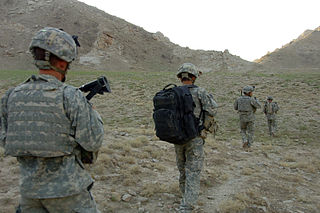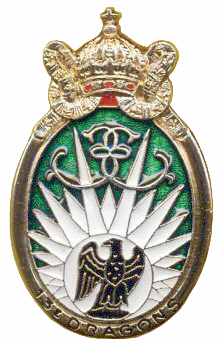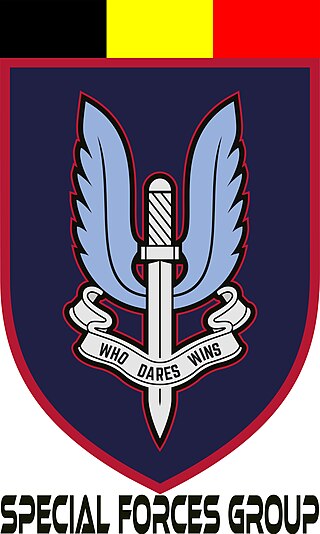
A long-range reconnaissance patrol, or LRRP, is a small, well-armed reconnaissance team that patrols deep in enemy-held territory.
Operation Gladio was the codename for clandestine "stay-behind" operations of armed resistance that were organized by the Western Union (WU), and subsequently by NATO and by the CIA, in collaboration with several European intelligence agencies during the Cold War. Although Gladio specifically refers to the Italian branch of the NATO stay-behind organizations, Operation Gladio is used as an informal name for all of them. Stay-behind operations were prepared in many NATO member countries, and in some neutral countries.

Long-range surveillance (LRS) teams were elite, specially-trained surveillance units of the United States Army employed for clandestine operation by Military Intelligence for gathering direct human intelligence information deep within enemy territory. Classic LRS employment is to infiltrate deep into enemy territory, construct hide and surveillance sites, and provide continuous surveillance/special reconnaissance of an intelligence target of key interest.

The Welrod is a British bolt action, magazine fed, suppressed pistol devised during the Second World War by Major Hugh Reeves at the Inter-Services Research Bureau. Station IX, being based near Welwyn Garden City, gave the Welrod its unusual name, being derived from "Wel" from "Welwyn Garden City" and "rod", gangland slang for gun, as a way to obscure its purpose.

The General Intelligence and Security Service (GISS), known in Dutch as Algemene Dienst Inlichting en Veiligheid (ADIV), and in French as Service Général du Renseignement et de la Sécurité (SGRS) is the Belgian military intelligence service under responsibility of the Minister of Defence. It is one of two Belgian intelligence services, together with the civilian Belgian State Security Service (VSSE).
The Belgian stay-behind network, colloquially called "Gladio", was a secret mixed civilian and military unit, trained to form a resistance movement in the event of a Soviet invasion and part of a network of similar organizations in North Atlantic Treaty Organization states. It functioned from at least 1951 until 1990, when the Belgian branch was promptly and officially dissolved after its existence became publicly known following revelations concerning the Italian branch of the stay-behind network.

The Special Actions Detachment or DAE is the tier one special force maritime unit of the Portuguese Navy. It is part of the Portuguese Marine Corps. Raised in 1985, the DAE is one of the smallest special forces units within the Portuguese Armed Forces. It is responsible for conducting air-sea rescue, amphibious reconnaissance, amphibious warfare, black operation, bomb disposal, CBRN defense, coastal raiding, counterterrorism, direct action, executive protection, hostage rescue, irregular warfare, ISTAR, long-range penetration, JTAC, manhunt high-value target, maritime sabotage, mountain rescue, naval boarding, operation behind high risk enemy lines, special operations, special reconnaissance, tracking targets, underwater demolition, unconventional warfare, other missions in support of Portuguese and NATO armed forces. DAE's mission and training are similar to American special forces and it often trains with them.

The 13e Régiment de Dragons Parachutistes or 13e RDP is a special reconnaissance regiment of the French Army. It is a unit of the French Army Special Forces Command, the latter itself being under the Special Operations Command. The regiment is based in Martignas-sur-Jalle.
Projekt-26, best known as P-26, was a stay-behind army in Switzerland charged with countering a possible invasion of the country. The existence of P-26 as secret intelligence agencies dissimulated in the military intelligence agency (UNA) was revealed in November 1990 by the PUK EMD Parliamentary Commission headed by senator Carlo Schmid. The commission, whose initial aim was to investigate the alleged presence of secret files on citizens constituted in the Swiss Ministry of Defence, was created in March 1990 in the wake of the Fichenaffäre or Secret Files Scandal, during which it had been discovered that the federal police, BUPO, had maintained files on 900,000 persons.
A clandestine operation (op) is an intelligence or military operation carried out in such a way that the operation goes unnoticed by the general population or specific enemy forces.

The Special Forces Group is the special forces unit in the Land Component of the Belgian Armed Forces.

Special reconnaissance (SR) is conducted by small units, such as a recon team, made up of highly trained military personnel, usually from special forces units and/or military intelligence organizations. Special reconnaissance teams operate behind enemy lines, avoiding direct combat and detection by the enemy. As a role, SR is distinct from commando operations, but both are often carried out by the same units. The SR role frequently includes covert direction of airstrikes and indirect fire, in areas deep behind enemy lines, placement of remotely monitored sensors, and preparations for other special forces. Like other special forces, SR units may also carry out direct action and unconventional warfare, including guerrilla operations.
National governments deal in both intelligence and military special operations functions that either should be completely secret, or simply cannot be linked to the sponsor. It is a continuing and unsolved question for governments whether clandestine intelligence collection and covert action should be under the same agency. The arguments for doing so include having centralized functions for monitoring covert action and clandestine HUMINT and making sure they do not conflict, as well as avoiding duplication in common services such as cover identity support, counterespionage, and secret communications. The arguments against doing so suggest that the management of the two activities takes a quite different mindset and skills, in part because clandestine collection almost always is on a slower timeline than covert action.
Throughout the Cold War, the U.S. conducted operations focused on combatting socialism in Turkey, executed chiefly through Operation Gladio's Turkish branch, the Counter-Guerrilla. The Syrian civil war has seen a resurgence of CIA activity in Turkey in recent years.

The Kampfgruppe gegen Unmenschlichkeit (KgU) was a German anti-communist resistance group based in West Berlin. It was founded in 1948 by Rainer Hildebrandt, Günther Birkenfeld, and Ernst Benda, and existed until 1959. Hildebrandt would later establish the Checkpoint Charlie Museum.
4/73 (Sphinx) Special Observation Post Battery Royal Artillery is a Surveillance and Target Acquisition (STA) unit of the British Army. It fields the British Army with long-range STA Patrols which provide specialist surveillance, reconnaissance and joint fires in high-threat environments. It is part of 5th Regiment Royal Artillery and is based at Catterick Garrison in North Yorkshire.

Daniele Ganser is a Swiss author and conspiracy theorist. He is best known for his 2005 book NATO's Secret Armies.
23 Special Air Service Regiment (Reserve) (23 SAS(R)) is a British Army Reserve special forces unit that forms part of United Kingdom Special Forces. Together with 21 Special Air Service Regiment (Artists) (Reserve) (21 SAS(R)), it forms the Special Air Service (Reserve) (SAS(R)). Unlike the regular SAS Regiment, it accepts members of the general population without prior military service.
The Study and Training Group for Military Reconnaissance was a highly classified clandestine unit of the foreign intelligence agency of Germany, Bundesnachrichtendienst (BND) from 1964 to 1979.
Detachment A also known as 7781 Army Unit, and 39th Special Forces Operational Detachment was a specialised unit within the 10th Special Forces Group founded in 1956 and based in Bad Tölz, West Germany later West Berlin. It consisted of approximately 90 members and operated primarily in Berlin.









